Do the Locomotion: The 19 Ways You Walk and Run in VR Games
VR Games' Locomotion Methods
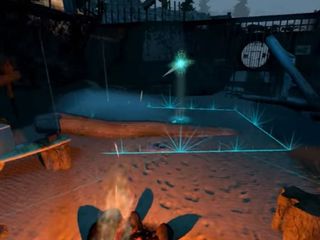
Before the advent of virtual reality headsets for home use, the most immersive gaming experiences that you could get at home were often first-person shooters. Virtual reality headsets bring you closer to the action than a monitor ever could, so you would think that FPS games and VR would go together like peanut butter and jelly. But it’s not that simple. Traditional FPS mechanics, when used in VR games, tend to trigger motion sickness. Fortunately, several creative developers have come up with locomotion solutions that make first-person VR games more comfortable. Here’s a look at the 19 that we know of.
MORE: Best Virtual Reality Headsets
MORE: All Virtual Reality Content
MORE: Virtual Reality Basics
Smooth Artificial Locomotion

Smooth Artificial Locomotion is the movement system that traditional gamers are most familiar with. It involves using a trackpad or thumbstick to navigate through virtual worlds as you would in a traditional console game.
When developers started experimenting with the Oculus DK1 and DK2 headsets, they soon learned that many people suffer from motion sickness in VR games. The perception of moving through a VR world as if you were walking, while your body is stationary, can cause a temporary "vestibular mismatch," which can trigger dizziness and malaise.
The reaction that early adopters experienced from smooth locomotion in VR prompted developers to create new methods, but the industry seems to be coming full circle. A military game called Onward proved that smooth locomotion could work well, and now many VR enthusiasts demand that it be an option in every game.
Stay on the Cutting Edge
Join the experts who read Tom's Hardware for the inside track on enthusiast PC tech news — and have for over 25 years. We'll send breaking news and in-depth reviews of CPUs, GPUs, AI, maker hardware and more straight to your inbox.
MORE: Best Virtual Reality Headsets
MORE: All Virtual Reality Content
MORE: Virtual Reality Basics
Dynamic FOV Reduction

In 2016, researchers at Columbia University discovered that dynamically reducing the field of view while moving in VR dramatically reduced the likelihood of triggering motion sickness.
Whenever users are in motion, the FOV begins to close in around them. This effect reduces the amount of detail they notice as they move through a virtual environment, in turn reducing the potential triggers for vestibular mismatch.
As a follow up to the research that started at Columbia University, Jason Jerald, author of The VR Book, created a game called VR Apocalypse that takes advantage of dynamic FOV reduction system.
This method is best paired with a smooth artificial locomotion system.
MORE: Best Virtual Reality Headsets
MORE: All Virtual Reality Content
MORE: Virtual Reality Basics
On-Rails Locomotion
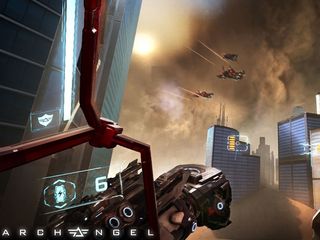
Skydance Interactive used an On-Rails Locomotion system for its mech game, Archangel, in which you are the commander of a 60-foot tall armored mech. Your viewpoint is that of the human commander on the bridge of the gigantic mech (think Pacific Rim). Your avatar’s body gets strapped into the mech, which gives you one-to-one control of the mech’s arms and makes it feel like you are one with the towering machine. But you never get to walk around as the mech.
The developer paced the action by spreading it across multiple partially scripted scenes, which gives it somewhat of a wave shooter feel. Between action sequences, the mech moves forward, but you don’t get to control where it goes.
MORE: Best Virtual Reality Headsets
MORE: All Virtual Reality Content
MORE: Virtual Reality Basics
Physical Movement – Planted
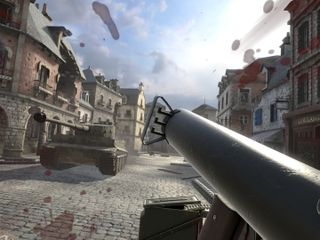
Instead of a movement system, Maxlvlgames built Front Defense to take advantage of the Vive’s room-scale tracking system. Front Defense’s locomotion system is all about physical movement. You can’t just stand up straight and expect to win a round of this game. You must duck behind cover and keep your head down if you wish to survive. Front Defense's gameplay is restricted to a single room-scale area. There's no way to move beyond your chaperone walls in this game.
MORE: Best Virtual Reality Headsets
MORE: All Virtual Reality Content
MORE: Virtual Reality Basics
Physical Movement – Active

Like Front Defense, Space Pirate Trainer doesn’t include an artificial locomotion system, and it relies on physical movement to get around. Unlike Front Defense, Space Pirate Trainer emphasizes rapid, active movements. In Space Pirate Trainer, you must be quick on your feet, and you must be willing to duck, dodge, and weave to avoid incoming enemy fire.
Games like this work best in large-volume play spaces. You can get away with a standing scale space, but players with room to move around enjoy a significant advantage.
MORE: Best Virtual Reality Headsets
MORE: All Virtual Reality Content
MORE: Virtual Reality Basics
Instant Teleportation
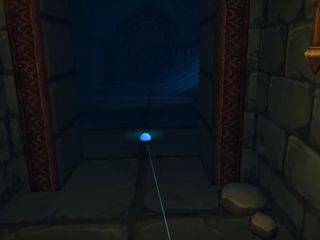
Teleportation is the most popular VR locomotion system. It allows you to traverse virtual spaces that are larger than your physical space. But not all teleport mechanics are equal. There are a variety of VR teleport methods, and each one offers a slightly different solution for the VR locomotion problem.
The most basic form of VR teleportation is the Instant Teleportation method. As the name would suggest, with this locomotion system, your movements from space to space are instantaneous. It doesn’t include a special animation to explain the movement. With this method, you point to where you want to go, and when you activate the movement button, you’ll be where you were pointing in the blink of an eye.
Vanishing Realms uses Instant Teleportation. It works, but there are more sophisticated teleportation systems that work better.
MORE: Best Virtual Reality Headsets
MORE: All Virtual Reality Content
MORE: Virtual Reality Basics
Teleport - Blink

As far as we can tell, Cloudhead Games’ Blink system was the first VR teleportation method. Cloudhead created Blink for The Gallery: Call of the Starseed, but many developers have adopted the method and used it in their games.
To move, press the thumbstick or trackpad forward, which will activate a reticle that you can place within a set radius from where you are. You can also rotate the thumbstick or your thumb on the trackpad to change your orientation while you move. The name "blink" comes from the way the scene “blinks” away in blackness momentarily as you move to your new location.
MORE: Best Virtual Reality Headsets
MORE All Virtual Reality Content
MORE: Virtual Reality Basics
Teleport Dash

The Blink teleport method works well, but it isn’t well suited for all situations. Blink is great for slow-paced games, but it breaks the immersion if used for action games. Raw Data from Survios is an example of one such game. It uses a variation of teleport locomotion known as Dash.
Dash is a better teleport mechanic for the close-quarters combat that Raw Data offers. The Dash system offers a button-activated reticle that you use to point to your next location, but instead of fading out the scene and then presenting the new location when the scene fades in again, you move to the new location at an ultra-fast pace. This allows you to retain a connection with your surroundings as you move.
MORE: Best Virtual Reality Headsets
MORE: All Virtual Reality Content
MORE: Virtual Reality Basics
Teleport Sprint
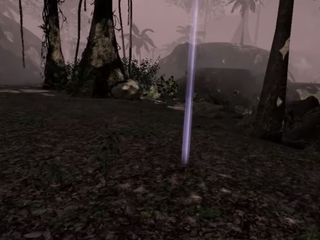
When Cloudgate Studio set out to create Island 359, the developer wanted to make the experience as immersive as possible. It didn’t like how the Blink teleport method broke up the gameplay, and it felt that teleporting took away from the visceral feeling of running away from the giant, angry dinosaurs. Cloudgate Studio created a new teleport method that strikes a balance between the often uncomfortable smooth locomotion, and the undesirable feeling of fading out and back into the virtual world.
Cloudgate Studio didn’t give its locomotion method a name, but we like to call it "Sprint teleportation." The Sprint teleport mechanic is a lot like Survios’ Teleport Dash system in that you can use the reticle to pick a spot to move to and then watch the world accelerate around you. But Cloudgate Studio added a stamina system to its movement mechanic, which is supposed to simulate the idea of running through the jungle. You can only run so far before you need to stop and catch your breath.
MORE: Best Virtual Reality Headsets
MORE: All Virtual Reality Content
MORE: Virtual Reality Basics
Teleport – Projected Avatar

Projected Avatar teleportation attempts to suspend the disbelief that teleporting promotes. With this teleport method, you still use a reticule to point out where you would like to move. However, instead of moving directly there, or rushing through the environment to the next location, you get to see a virtual avatar of yourself moving through the area before you decide where you wish to go next.
You still teleport to the selected location, but the animation of the avatar allows you to understand the route you took to get there. It also gives a better explanation of why you can’t teleport past immovable objects, or over a balcony to the ground below.
We’ve seen Projected Avatar teleportation in a handful of games, but the most recent, and perhaps best, example of the movement system comes from Gunfire Games, in its recent Oculus Rift exclusive title From Other Suns.
MORE: Best Virtual Reality Headsets
MORE: All Virtual Reality Content
MORE: Virtual Reality Basics
Kevin Carbotte is a contributing writer for Tom's Hardware who primarily covers VR and AR hardware. He has been writing for us for more than four years.
-
AgentLozen I have very little experience with VR but I assume that the author spent a lot of time in VR while doing research for this article. How would you rank these styles of locomotion?Reply -
husker If VR is ever going to become mainstream, this will need to be standardized and remain immersive. People are NOT going to pay the premium price and go through the effort to set up a VR space just so they can be forced to "teleport" or "dash" or "sprint" or whatever in an un-immersive way. After ruling out a warehouse as a play space or an omni-directional treadmill, there is only one simple way to do this. and that is to track one or both feet. Why this isn't even considered is beyond me, especially since they came so close with the "arm swing" and "head bobbing" methods. Any other method should be reserved for people who have a physical disability or just don't feel like putting out the effort for real VR.Reply -
junglist724 And this is why simracing and flight sims are the only truly good gaming applications for vr right now. The locomotion problem is eliminated by peripherals.Reply -
photonboy Husker,Reply
It's already possible to track limb movement. Even the KINECT can do this for the XBOX.
Here's a list of products that are either available or in development for full body VR tracking: http://virtualrealitytimes.com/2017/02/21/list-of-full-body-vr-tracking-solutions/
And "mainstream" would not describe movement-based VR anyway. Only a very small percentage of people would have the capability to setup a sufficiently large area to walk around in. Most people will surely just SIT. -
kcarbotte Reply20785359 said:I have very little experience with VR but I assume that the author spent a lot of time in VR while doing research for this article. How would you rank these styles of locomotion?
I believe that teleport mechanics work well, but the best solutions are Armswinger and Head-Bobbing.
Survios also combined several locomotion systems and called it the Fluid Locomotion System, which includes armswinger, grabbing the environment and the superman locomotion all together. That solution works really well. You can try it in Sprint Vector.
Most Popular

